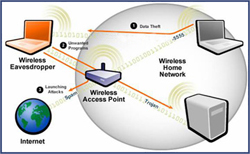Analyze every basic step in wireless network design
From a network design standpoint, the wireless system will gain a lot of favor but cannot completely replace wired connections. The main reason for this is that there are still some inconveniences in the wireless system. However, today we can see clearly that wireless LAN applications are developing very fast and have many advantages for the future. Over the past few years they have been increasingly improved in speed, security, quality of service and centralized management. That may suggest that over time we can completely abandon traditional wiring designs?
Identifying a network that should be designed to be wired or wireless or a combination of both is essential in the network design process. Usually this decision depends on what work has been done before and what the outcome is. Today systems often change very quickly, requiring us to carefully analyze the design of a network.
Check out some of the LAN design projects where we show you what to consider and consider when doing this.
Technology and trends
First you need to understand and know about the technologies already on the market and their future trends. Today it is common for Ethernet systems with speeds of 100Mbit / s and up to 1Gbit / s on twisted-pair cables.
For wireless systems, 802.11b standards have been verified in WLAN connectivity, in addition 802.11a and 802.11g also allow high-speed transmission.
The need for bandwidth is increasingly important. Therefore, IEEE has focused on extending bandwidth-enabled capabilities in both wired and wireless systems. 802.3an launched last year can provide 10Gbit / s. Ethernet on copper cable and IEEE 802.3 Higher Speed Study Group have announced it will focus on developing a new standard that allows up to 100Gbit / s - Ethernet over copper standard
 According to 802.11 Official Timelines, 802.11n promises to provide throughput of up to 540Mbit / s and is projected to be approved as a standard in April 2008. 802.11n-based devices (draft versions) like Linksys Wireless- N Broadband Router has launched on the market. However, the installation based on an old standard needs to consider the issue of the ability to cooperate in the future.
According to 802.11 Official Timelines, 802.11n promises to provide throughput of up to 540Mbit / s and is projected to be approved as a standard in April 2008. 802.11n-based devices (draft versions) like Linksys Wireless- N Broadband Router has launched on the market. However, the installation based on an old standard needs to consider the issue of the ability to cooperate in the future.
The important thing to note here is that the network equipment industry is producing products for both environments with large bandwidths, wiring systems continue to play a major role in the problem. flux.
Convergence is a trend that will continue. VoIP is not only an option for wiring, with softphone and sets of 802.11b such as Cisco Unified Wireless IP Phone 7920 have been launched. Many access points for QoS to ensure the necessary bandwidth on the call is also available. Voice terminals (wired or wireless) do not require much bandwidth on a call (64kbit / s) but require low latency. A QoS configured access point can ensure that a large file can be downloaded without interfering with other users' calls.
Convergence does not stop at VoIP. Roaming between IP and honeycomb networks is also offered in a T-Mobile project in certain areas.
Keeping up with the development of technology and trends is an important issue, but that's not enough. You need to clearly understand what is needed for a network from a user perspective.
Network and security issues
When designing a network, it is necessary to consider what kind of data the network will transmit. A simple network that speaks can be considered a tool and obviously you have to use the right tools for the job. Through such an analysis will ensure satisfactory network performance.
The necessary bandwidth requirements for the applications to be used should be given. Two specific application bandwidth requirements to consider are: throughput and latency. The throughput is the data transfer rate, calculated by bit / s, and the delay is the time delay in data transmission.
Some applications, such as software downloads, web browsing and e-mail, work well with a lagged system because latency time here is not noticeable. As mentioned above, real-time applications such as VoIP do not require large throughput but have low latency. Some places need to have large data transmission like online backups, the throughput must be large but the delay is not important.
A user connected to an access point with 54Mbit / s speed that the cable system allows 100Mbit / s, the connection to be transferred will give an acceptable performance. But for all wireless designs it is not equal because some coefficients will reduce user performance.
 Access point connection is a shared network model. Users connecting to an access point are downloading a 3.5GB Linux data file DVD ISO from the local network can get 50Mbit / s average (satisfactory) throughput from an 802.11g access point. At this rate, the file download will end within (3.5GB * 8b / B) / 0.05Gbit / s =) 560s, less than 10 minutes.
Access point connection is a shared network model. Users connecting to an access point are downloading a 3.5GB Linux data file DVD ISO from the local network can get 50Mbit / s average (satisfactory) throughput from an 802.11g access point. At this rate, the file download will end within (3.5GB * 8b / B) / 0.05Gbit / s =) 560s, less than 10 minutes.
If adding 9 computers that are loading the same file, the task will be completed on about 1.5h ((3.5GB * 10 * 8b / B) /0.05Gbit/s=5.600s). If all 10 computers are connected to a 100Mbit / s switch by a line to a 1Gbit / s server, the file download will be completed in 1/20 time or about 5 minutes. Other variables such as contention, packet overhead and signal length are ignored in this example, but in general it illustrates the importance of different bandwidth types.
There are many inherent limitations to the number of connections at an access point. A good design formula is that each access point can support about 20-30 users simultaneously. Applications that do not require high bandwidth and low latency will have difficulty in performance when the number of concurrent users in an access point is too large.
How important access points are to the backbone network. In the previous example, the wireless access point was admitted that there was a 100Mbit / s backbone connection in the uplink (uplink). What about the network? Depending on how the network is arranged, an uplink of 54Mbit / s can connect an access point and divide it into two other points, the capacity of the line up to the backbone network for each point will decrease. 50%. More access points, bandwidth will be further reduced.
If the main purpose is for Internet access, the bandwidth limitation is in the ISP connection. In that case, LAN bandwidth limitations do not need to worry too much. In terms of mobility and cost, the wireless system may be the way to go, but it also faces difficulties in security. Wireless networks will have more complex issues in security because this is its inherent in the space it covers.
In fact, cable signaling systems will ensure better security than radio signals. However, with the addition of applications like SSL / SSH, VPN, 802.11i and Network Access / Admission Control in wireless networks, there is a significant reduction in security risks.
Wireless networks are, in a mobile aspect, more obvious than wired networks. They can let you connect anywhere, anytime. So if bandwidth risk issues are resolved, the wireless system may be the system that will be selected. Remember that this is not a technical decision, but a technique that is only a tool aimed at the desired results of the user.
Cost and management
It is clear that when designing a network one must always take into account the cost of a cable because a wireless computer network still has some cables. However for access points (in the case of designing a network) the costs can be reduced by using wireless systems.
Cost can also be lower by adding wireless access points within large networks. Usually wireless network deployments often use large access points, where each point is individually configured. Centralized management system such as Enterasys's RoamAbout Switch System converts all of its capabilities obtained from access points to each device. With the benefits described below, centralized access point management has become a popular method of wireless installation.
In traditional WLAN design, small wireless access points are connected to the corporate network via a virtual LAN (VLAN) Layer 3. A VLAN is distributed through trunking or building a virtual network can be related. Significant to configuration and equipment costs. A VLAN is hoped for security issues and is often separated from the corporate network by a firewall and a VPN concentrator.
 The deployment of a centralized wireless system allows VLAN to be extended on an existing wired network. The access point creates a tunnel for central management, regardless of what VLAN is set up on.
The deployment of a centralized wireless system allows VLAN to be extended on an existing wired network. The access point creates a tunnel for central management, regardless of what VLAN is set up on.
In other words, an access point can be placed on one VLAN and another is on another VLAN, and in both example wireless clients will be on a wireless VLAN. This will make it much easier to deploy wireless networks where fixed wiring infrastructure is available.
The centralized model also provides other features. Configuration changes are applied at the management switch instead of at each access point. When access points are communicating with the central device, advanced features such as automatic channels, source configuration and phishing detection are possible.
The inconvenience for centralized models is the very high costs. Centralized management is usually sold at very high prices. However, if deployments involve multiple access points or wireless extensions that are intended in the future, these costs are completely practical and worthwhile.
Conclude
As mentioned above, a mixed network is often preferred. However, due to the changing nature of network technology, grasping the technologies in wireless or wireless applications is essential in designing a network design project. It is important to understand what capabilities are available and incorporate the requirements and policies of the company, which is paramount to the design of an optimal network.
 Network basics: Part 1 - Network hardware devices
Network basics: Part 1 - Network hardware devices Wireless standards are highly appreciated today
Wireless standards are highly appreciated today Balance downloading Web-Proxy Client with ISA Server 2004 Standard Edition
Balance downloading Web-Proxy Client with ISA Server 2004 Standard Edition The scarcity of WiMax 'pliers' voice service
The scarcity of WiMax 'pliers' voice service Balance downloading Web-Proxy Client with ISA Server 2004 Standard Edition (Part 2)
Balance downloading Web-Proxy Client with ISA Server 2004 Standard Edition (Part 2) Advanced TCP / IP settings in Windows 2003
Advanced TCP / IP settings in Windows 2003